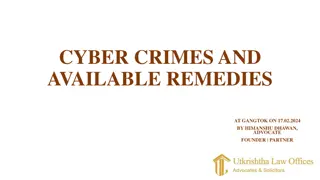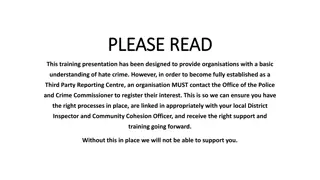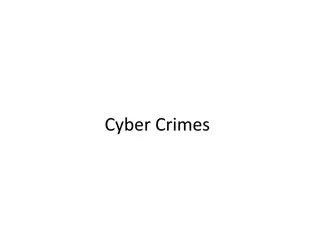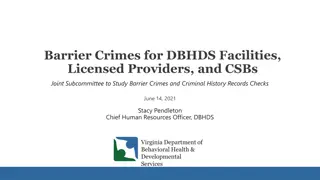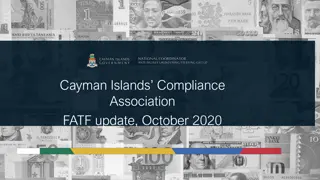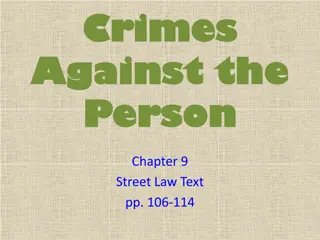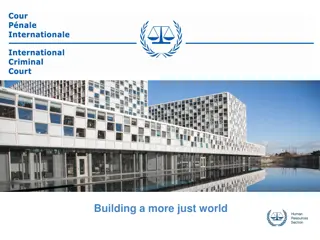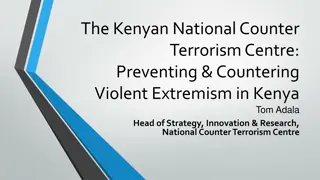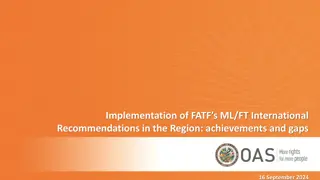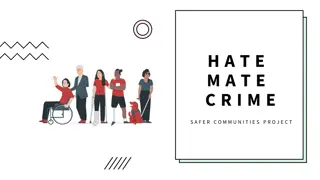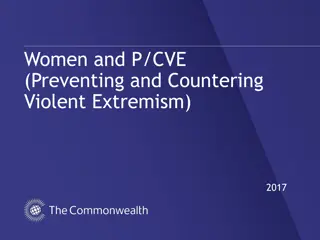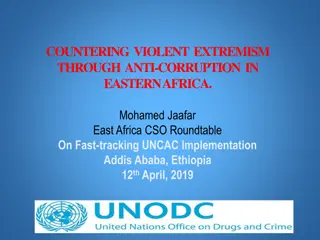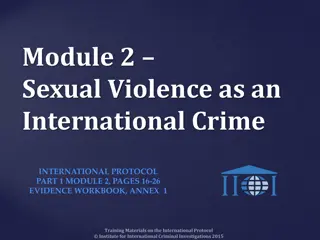Understanding the Role of FATF in Countering Financial Crimes
The Financial Action Task Force (FATF) plays a crucial role in setting global standards to combat money laundering and terrorist financing. Established in 1989, FATF conducts research, sets standards, and evaluates countries' compliance to mitigate risks. With 198 member countries committed to implementing these standards, FATF's work contributes to strengthening financial sector integrity and enhancing safety and security worldwide.
Uploaded on Sep 27, 2024 | 0 Views
Download Presentation

Please find below an Image/Link to download the presentation.
The content on the website is provided AS IS for your information and personal use only. It may not be sold, licensed, or shared on other websites without obtaining consent from the author. Download presentation by click this link. If you encounter any issues during the download, it is possible that the publisher has removed the file from their server.
E N D
Presentation Transcript
Description: EFC.bmp The Global NPO Coalition on FATF The ABCs of FATF: What Nonprofits Need to Know in 2017 and Beyond December 15, 2016 Speakers: Kay Guinane, Charity & Security Network Lia van Broekhoven, Human Security Collective Lara Kalwinski, Council on Foundations Haroun Atallah Transparency International Ben Evans, Greenacre Group Vanja Skoric , European Center for Not-for-Profit Law Suzanne Keatinge, Dochas This event organized, in part, under the project: Standing up Against Counter- Terrorism Measures that Constrain Civic Space . The project is supported in part by the grant from the Open Society Human Rights Initiative. The views in the paper do not necessarily represent the views of the Open Society Foundations. For more information visit: www.fatfplatform.org
Global NPO Coalition on FATF Lia van Broekhoven, Human Security Collective 2
What is the FATF and Why is it important The global standard setter for anti money laundering and countering financing of terrorism standards FATF assumes that if countries effectively implement these standards, financial systems and the broader economy are protected from the threats of money laundering and the financing of terrorism thereby strengthening financial sector integrity and contributing to safety and security 198 countries have committed to implement the standards
Who is the FATF An intergovernmental body established 1989 by the G 7 Standards to counter terrorism financing included after 9/11 A task force and not a formal organization 37 Members and 9 regional bodies represented by MinFin Works in close partnership with the UN, IMF and World Bank A secretariat facilitates the work of the FATF and regional bodies located in Paris at OECD Chaired by president plenaries to discuss compliance with standards based on evaluation reports Decision-making by consensus
What does the FATF do Researches ways criminals launder money and terrorist organizations raise and access funds Sets global standards to make it more difficult for criminals and terrorists to do this Assesses how effective countries are at implementing the standards and mitigating risks through rigorous peer evaluations
Why do civil society, nonprofits have to know about the FATF One standard, Recommendation 8 is entirely dedicated to nonprofits It singles out nonprofits for being vulnerable for terrorism financing abuse Nonprofits need to be protected by government laws and regulations Governments have intentionally and unintentionally implemented the standard in ways which led to push back of civil society Banks being required to shore up government agendas in tackling money laundering and countering terrorism financing are de-risking nonprofits The way Recommendation 8 has been interpreted and implemented by governments and banks important driver of the constraining of civic space and financial exclusion
NPO engagement with the FATF Constructive and critical engagement since 2013 Consultations with civil society in the process of revision of Recommendation 8 and on country evaluations Current challenge - civil society to have a permanent representation at the FATF Private Consultative Group meetings Regional FATF bodies seek engagement with nonprofits Opportunity to strengthen engagement world-wide and potential driver for further reclaiming civic space
Global NPO Coalition on FATF Lara Kalwinski, Council on Foundations 8
Rationale for change of R8 according to FATF : 1. NPO sector and the threat environment has changed 2. Reflected in two FATF papers: 2014 Typologies report and 2015 revised Best Practice paper (RBA) 3. Revised standard aims to ensure that: Implementation of R8 in line with risk-based approach and does not disrupt or discourage legitimate NPO activity
TAKE THE TIME TO READ: New Recommendation 8 on NPOs Countries should review the adequacy of laws and regulations that relate to non-profit organisations which the country has identified as being vulnerable to terrorist financing abuse. Countries should apply focused and proportionate measures, in line with the risk based approach, to such non-profit organisations to protect them from terrorist financing abuse, versusold Recommendation 8 on NPOs Countries should review the adequacy of laws and regulations that relate to entities that can be abused for the financing of terrorism. Non-profit organisations are particularly vulnerable, and countries should ensure that they cannot be misused: .
Removal of particularly vulnerable: 1. Previous language singled out the NPO sector to be particularly vulnerable 2. led to overregulation and inappropriate restrictions on NPOs, 3. hampering their legitimate and essential work around the world. NPOs around the world have been stressing the need to stop singling out the sector
Risk-based approach what does it mean? 1. Countries should identify which organisations fall within the FATF definition of NPO, and 2. Identify which of those are vulnerable to terrorism financing abuse (subset). 3. Countries should review adequacy of measures, laws and regulations that relate to this subset 4. Measures must be focused and proportionate in line with a risk-based approach
FATF R8 INTERPRETIVE NOTE SUMMARY WHAT IS GOOD AND WHAT WE SHOULD WATCH OUT FOR BY HAROUN ATALLAH GROUP DIRECTOR CORPORATE SERVICES TRANSPARENCY INTERNATIONAL
STRUCTURE OF IN R 8 INTRODUCTION OBJECTIVES AND GENERAL PRINCIPLES MEASURES RESOURCES FOR SUPERVISION, MONITORING AND INVESTIGATION A B C D 14
A. INTRODUCTION This recommendation only applies to organisations within the FATF definition of NPO. NPO refers to an organisation that engages in disbursing funds for purposes such as charitable, religious, cultural, educational, social or fraternal purposes (all good work). Recognition of the important role played by NPO s, the efforts by the sector to manage risks, yet cases where charitable organisations or sham charitable organisations were used to facilitate terrorism were identified. Reminder that implementation by countries must respect obligations under the UN Charter and international Humanitarian law. Reasons for vulnerability of sector identified. 15
B. OBJECTIVES AND GENERAL PRINCIPLES The objective is to ensure NPO s are not misused by terrorists by following these principles: A risk based approach Flexibility in developing a national response to terrorist financing abuse of NPO S. Countries adopt effective and proportionate measures commensurate with risk-based approach. Measures should promote accountability and engender greater confidence amongst all parties including the public that funds reach their intended beneficiaries. Countries should aim to prevent and prosecute as appropriate, terrorist financing and other forms of terrorist support. Countries should encourage the development of academic research on, and information sharing in NPO s to address terrorist financing related issues. This should be based on developing cooperative relationships with both the public and private sectors as well as NPO s. 16
C. MEASURES Countries should identify which subset of organisations fall within the FATF definition of NPO that is at risk. An effective approach should involve all four of the following elements in order to protect NPO s from potential terrorist financing abuse: 1. Sustained outreach concerning terrorist financing issues 2. Targeted risk-based supervision or monitoring. NPO s could be required to licence or register 3. Effective investigation and information gathering 4 Effective mechanisms for international cooperation should include capacity to respond to international requests for information about an NPO of concern. 17
D. RESOURCES FOR SUPERVISION, MONITORING AND INVESTIGATION Countries should provide their appropriate authorities, which are responsible for supervision, monitoring and investigation of their NPO sector, with adequate financial, human and technical resources. 18
AREAS WE SHOULD LOOK OUT FOR How are the subset of NPO s whose activities or characteristics may be subject to terrorist risk abuse identified? Executive orders as a means for taking action against NPO s should be temporary and subject to a transparent judicial process. Laws and regulations being tailored to a subset of vulnerable NPO s seems like an unrealistic demand. NPO s being required to license is not the same as register as the wording implies. Beneficiary identity Setting a minimum period for maintaining records of five years 19
National Risk Assessments and Risk Assessments for the NPO Sector Ben Evans, Director, Greenacre Group
Two things to look our for R1: National Risk Assessment (NRA) Countries should identify, assess, and understand the money laundering and terrorist financing risks for the country... (FATF Methodology, 2016) R8: Identifying NPOs at risk identify the features and types of NPOs which by virtue of their activities or characteristics, are likely to be at risk of terrorist financing abuse. (FATF Methodology, 2016) 21
Their Significance Setting the TF Agenda Justifies national policies and actions In some cases, an opportunity to prevent excessive regulation It may be possible that existing measures are sufficient to address the current TF risk to the NPO sector identified in a country. Best Practices Paper, 7(b)) 22
Problems and Risks No data Confidentiality Circular categorisation Singling out De-risking 23
Opportunities: Risk based approach The requirements of Recommendation 8 only apply to those NPOs which are considered at risk for terrorist financing purposes. Regulation must be justified Undermines old safety-first approach of over-regulation 24
Opportunities: Consultation FATF expects authorities to consult with all stakeholders when undertaking a risk assessment; Stakeholders should include civil society; Evaluators will be looking for evidence of such consultation when assessing R1 and IO.1; That R1 and IO.1 are the most important of the Recommendations and Immediate Outcomes; and furthermore... That countries should specifically work with NPOs to develop and refine best practices to address terrorist financing risk and vulnerabilities in the NPO sector. 28
Actions National level focus Engage with the FIU Challenge the old narrative 29
Actions National level focus Engage with the FIU Challenge the old narrative 30
Global NPO Coalition on FATF Vanja Skoric, European Centre for Not-for-Profit Law 31
Risk Risk is the core of FATF standard - increasingly in the latest MERs published in 2016 If the government did not carry out risk assessment or risk-based approach, the country would likely not be compliant with R8 32
Risk Hungary- no specific RA on NPOs; no outreach to NPOs - should conduct a formal review of the entire NPO sector in order to identify those NPOs falling within the relevant FATF definition, and identify NPOs that could potentially pose a higher FT risk. (R8 PC) Honduras- no RA on NPOs; no specific outreach to NPOs - the assessment and understanding of TF risk could be improved with the inclusion of DNFBPs and NPOs into the country risk analysis. (R8 - LC) 33
Effectiveness Effectiveness is key in relation to methodology Evaluators ask for effective, targeted approach Untargeted measures that restrict operating space of the entire NPO sector should be considered as non-compliant, as they are not effective Evaluators can challenge effectiveness and use of resources when regulation imposed on entire sector Evaluations could be an entry point to emphasise overregulation is ineffective 34
Effectiveness Low level of implementation on effectiveness in current 4th round of FATF evaluations on R8 - only 20% of countries assessed are doing well Uganda - no specific RA on NPOs; no outreach to NPOs - Sanctions prescribed in the Non-Governmental Organisations Act Chap 113 as amended in 200623, of a fine or of less than one year imprisonment or both are not dissuasive, effective or proportionate enough and are not related in any way to TF. (R8-NC) 35
Effectiveness Tunisia - no specific RA on NPOs; no outreach to NPOs - level of effectiveness achieved for Immediate Outcome 10 is low The Law establishes transparency measures to identify those responsible for the administration and management of associations and ensures the integrity of incoming and outgoing funds by publication of the financial statements of the associations. (R8-LC) 36
Outreach If no outreach to the non-profit sector was conducted, if there was no discussion about terrorism financing and risks with NPOs, it is difficult for that country to score well on R8 MERs could also cite whether NPOs showed awareness of their sectorial vulnerabilities to FT threats (Belgium, Serbia) 37
Outreach Serbia no specific RA on NPOs; no outreach to NPOs A formal review of the NPO sector should urgently be undertaken with regard to its activities, size and vulnerabilities to FT and adequate awareness-raising programmes should be carried out. (R8 - PC) Switzerland no specific RA on NPOs; no outreach to NPOs - authorities have not conducted any outreach or training activities in the sector on TF risks. Some self-regulatory organisations are working hard at supervision, outreach and training in the NPO sector, particularly through certification and the spread of best practices. However, these are optional initiatives. (R8 - PC) 38
Entry points and recommendations Assessed Country Trainings - encourage countries to use the opportunity of trainings offered by FATF/FSRBs, to prepare for evaluation process/include R8 Identifying sub-sector of NPOs at risk - develop clearer guidance for governments how to identify, and for evaluators on the effectiveness review 39
Entry points and recommendations Global Network Coordination Group (incl. FATF and FSRBs Secretariats, WB, IMF) - share evaluation-related material developed by FATF Secretariat among members to help facilitate and simplify the process These might include templates and guidance on NPO engagement 40
Entry points and recommendations Guidance to evaluators on engaging with NPO sector - standardized approach that can consider good practices: - Provide information on how NPOs can be informed in advance to prepare for evaluation - Provide guidance on how NPOs can submit input to evaluators prior to the visit (i.e. FATF templates for inputs made available to NPOs) 41
Global NPO Coalition on FATF Suzanne Keatinge, Dochas 42
Questions asked of Irish NGOs as part of FATF assessment 15 November 2016 1. How are charities vulnerable to terrorist financing? 2. Have charities taken steps to address vulnerabilities? 3. What information/guidance is given by the government/charities regulatory authority (CRA) to NGOs re terrorist financing 4. National Risk Assessment were you involved in the process? 5. What were charities experience of the registration process for CRA? 6. Have there been any inspections of registered charities? 7. To the extent that it has been possible, what has been the government/regulators approach on terrorist financing? 8. What work still needs to be done? How do you think you could get more support from the authorities? 9. To what extent is Ireland applying focussed proportionate measures to NPOs? 10.What kind of sanctions could governments/regulator apply? 11.Do you agree with the National Risk Assessment 12.Are there any ways the government/CRA could improve re Terrorist financing 43
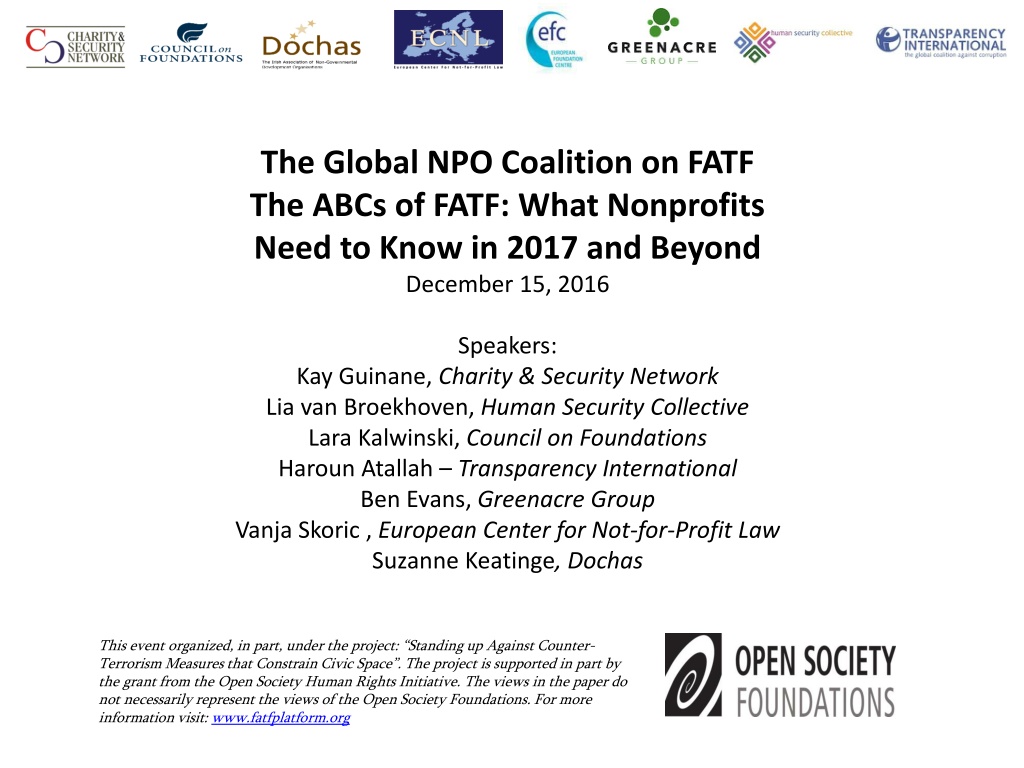


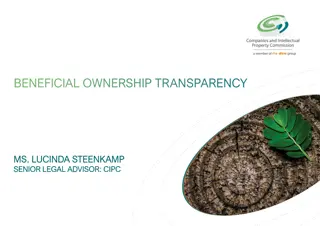
![Prevention and Combating of Hate Crimes and Hate Speech Bill [B.9B.2018]](/thumb/60513/prevention-and-combating-of-hate-crimes-and-hate-speech-bill-b-9b-2018.jpg)

